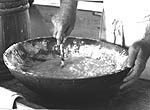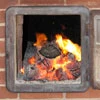|
Yeast
The first step in making bread is to prepare the yeast. Yeast is important when making light bread. There are hundreds of varieties of yeast occurring in nature, and they are known as wild yeast. The outstanding characteristic of yeast is its ability to convert sugar to carbon dioxide and alcohol. The process of using yeast has been in use since at least the year 2000 B.C; Brewer's yeast has been used for making beer, wine, ale, and bread nearly as long. But the commercial manufacture of a special yeast for bakers did not begin until 1870.
In 1803, the US Army dictated that light bread was necessary to a soldier's diet, and from that time until the advent of baker's yeast, the process of making light bread was by the fermentation method. The fermentation method involves eight successive steps; the first two of which are involved in making the yeast: making a head yeast or starting a ferment and making stock yeast.
The directions in the manuals called for making head yeast to make the dough rise. Hops and potatoes were combined with malt or sugar to make the yeast react quickly and increase the fermentation. The requisition for hops for the bakery at Fort Laramie in 1849 indicates the Army was sending these to some of their western posts early, but there is no record of hops at Fort Scott. Sugar was available at all posts, including Fort Scott. Head yeast was made in a special tub, which was cleansed so it was free of grease by mixing flour and soft water from which boiled hops had been strained. Ground malt, or porter, was added and the tub covered for 24 to 36 hours to allow the yeast to rise, fall, and settle. Before it was used, the resulting batter was strained.
The concentrated head yeast was diluted to make a stock yeast, which actually fermented the dough before baking. The stock yeast was a combination of flour, water, hops, malt, and head yeast. After adding malt, a portion of the head yeast was placed in a batter, which was covered for about 24 hours. The stock yeast had the virtue of lasting for as long as two weeks, but it was sensitive to climate and even thunderstorms.
In warm weather stock yeast should be made daily; in cool weather every third day; in cold weather twice a week. A new stock yeast should be on hand before the existing supply has been used.

The Sponge
The sponge was the thick batter or leavening that fermented the baking dough. It was made by blending the stock yeast with enough flour and water to make a homogeneous consistency, which was allowed to rise and partially fall. This latter process lasted from six to eight hours. Ripe sponge was ready to have flour added along with water containing dissolved salt, Sponge allowed to go too long before "breaking" or adding the water and flour, made heavy, flat, sour bread.
The Dough
When it was time to make the baking dough, water and salt were added to the sponge. While salt enabled the dough to absorb more water, making more bread with the flour allotted, care had to be taken that too much salt was not used, which would retard fermentation and reduce the size of the bread loaf. Sifted flour was placed with the moist sponge in a wooden trough for kneading. The dough rose in the trough from two to five hours, depending on the type and strength of yeast used. Once the dough had risen, it was divided into loaves of 18 ounces and placed in well-greased bread pans for a second rising. Lard was rubbed over the tops of the dough loaves to prevent the crusts from becoming hard; they were covered with a cloth; and the dough was placed in "proof racks". Bread that rose too much could fall and produce sour, heavy bread, but that which rose too little could make heavy damp loaves. Information for this page was taken from the Historic Furnishing Plan for The Bake House by Sally Johnson Ketchum and from an anonymous article on file at Fort Scott. |
Last updated: July 26, 2016

